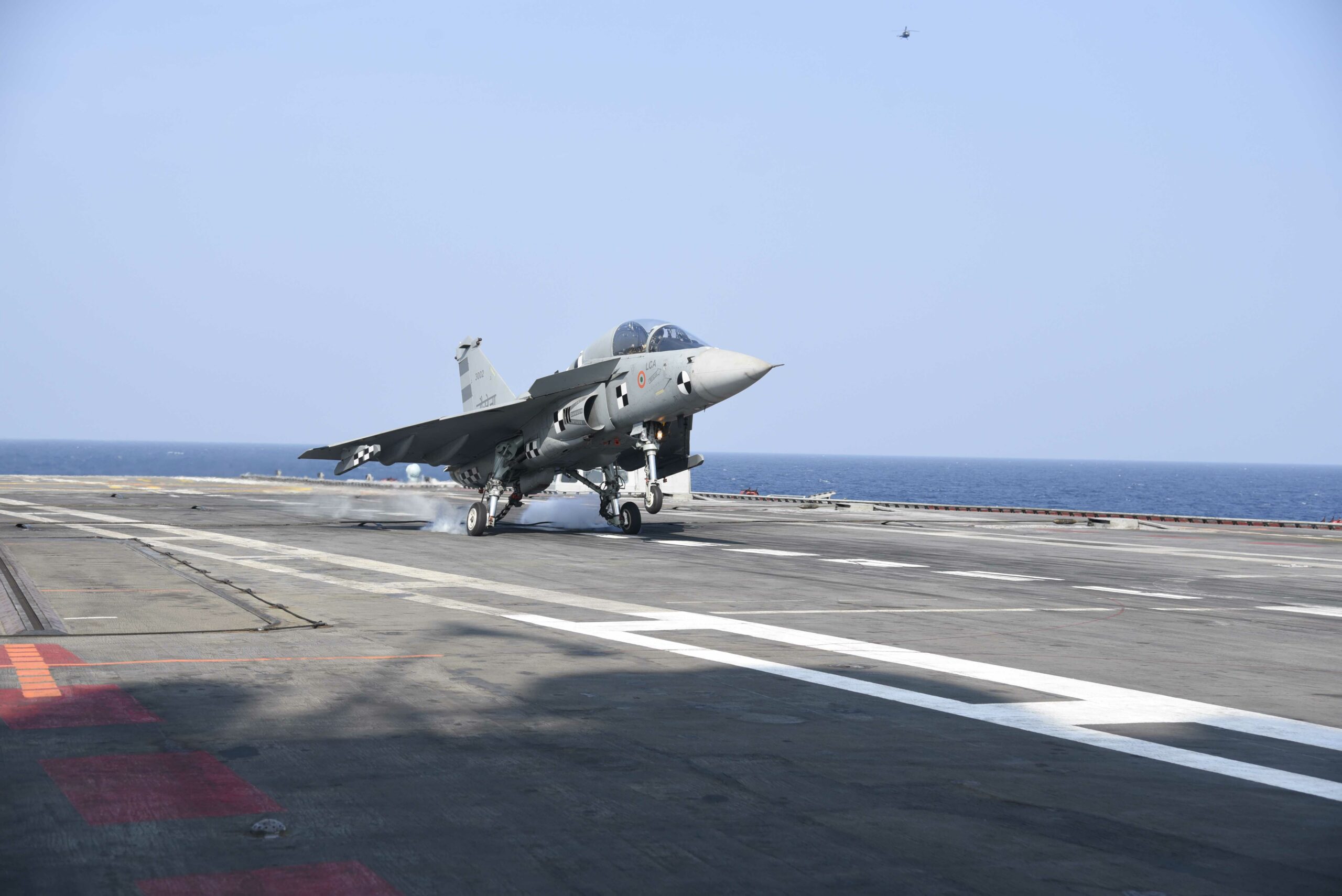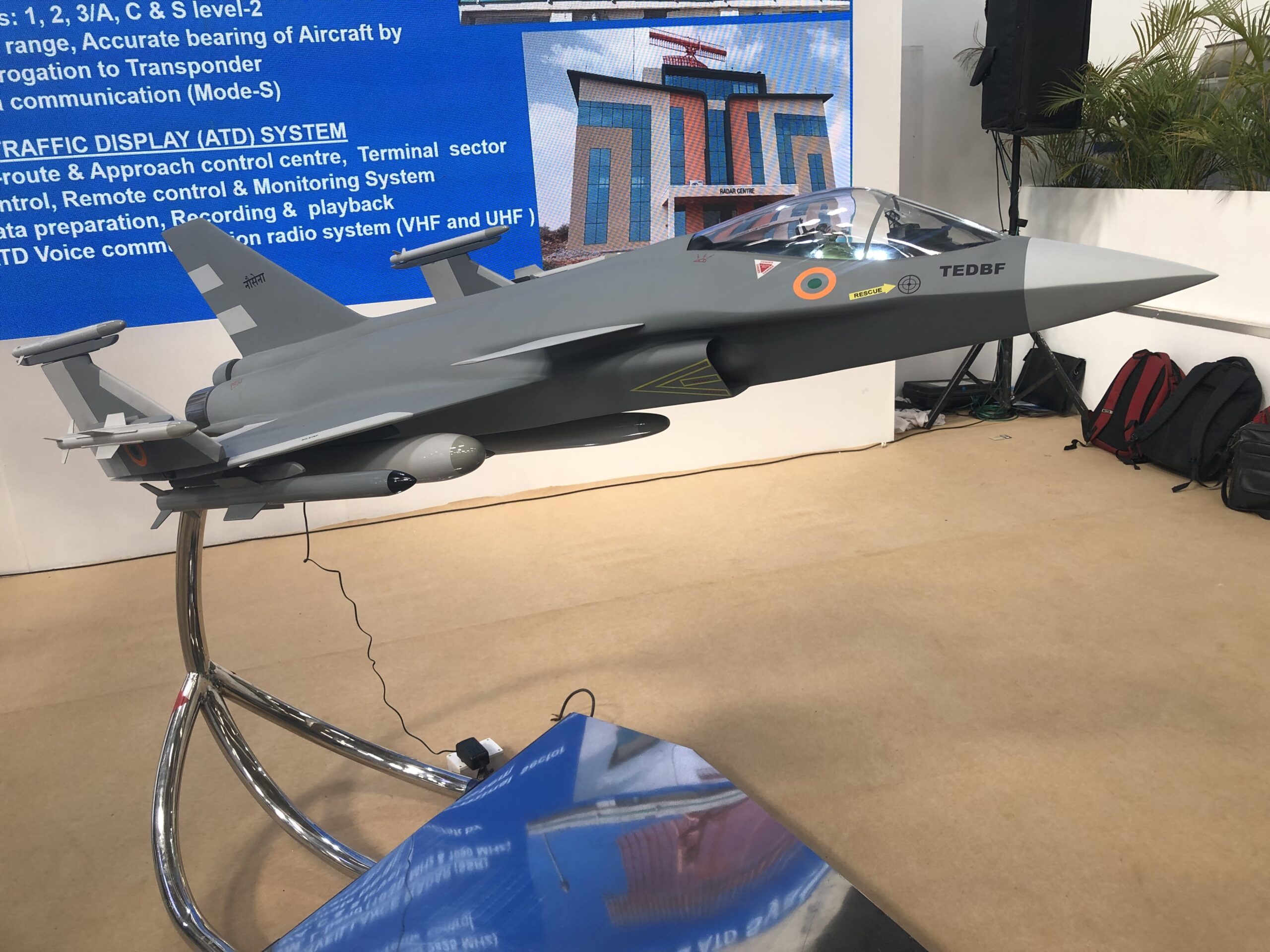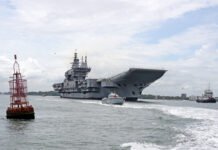India made history recently when two fixed-wing fighter aircraft made back-to-back maiden landings on board the nation’s first indigenous aircraft carrier INS Vikrant. The landings were made by an indigenous Indian fighter, the Light Combat Aircraft (LCA) Navy and a MiG-29K jet in early February this year at the Indian Naval Air Station (INAS) Hansa, Goa, in western India.
Former Indian Naval Chief Admiral Karambir Singh (retd.), himself an aviator, said: “The indigenous LCA landing on the indigenous Vikrant was indeed a proud moment for all of us. It goes to prove that the design of our carrier deck with associated wind-flow calculation was spot on.”

Credit: DRDO
The historic landings mark one step further towards making INS Vikrant fully operational. The carrier, which is currently in the middle of critical flight and sea trials, was commissioned in September 2022, and is expected to become fully battle-ready by the end of 2023. Both flights, by the LCA and the MiG-29K, were basic in nature, and the complete envelope of the complex flight trials is expected to be concluded in the next three-four months. Most weapons testing and rotary wing trials have almost been concluded. Indian Navy’s Vice Adm Shekhar Sinha (retd.) stated: “Large number of sorties are required to develop the Operating Data Manuals which form the basis of future operations. Each weapon configuration with different wind on deck has to be flown and the flight envelope has to be plotted.”
The maiden flight was carried out by the single-engine LCA Navy technology demonstrator, currently incapable of full operations, is considered the precursor to the indigenous twin-engine deck-based fighter (TEDBF), presently awaiting Government sanction. Admiral Karambir (retd.) adds, “The LCA Navy was to be a technology demonstrator and a platform that would help in the design of our operational deck fighter, the TEDBF. The Government should not delay sanction of the TEDBF anymore as we need to have the first prototype out by 2026.”
As Indian and foreign naval fighters carry out landings and evaluation trials, the state-run defence agencies such as the Defence Research and Development Organisation (DRDO), Aeronautical Development Agency (ADA, Hindustan Aeronautics Limited (HAL) and the Indian Navy are quietly working on the TEDBF, their most ambitious and most advanced naval fighter project. With DRDO as the lead agency, the Indian Navy is preparing a Cabinet draft note for the development and design of the TEDBF. Before any Cabinet sanction, the Navy is required to carry out design drawings and simulations, after which the ADA will inform the Government that it is feasible to operate such an aircraft.
The principal agencies for this twin-engine, medium-weight, short take-off but arrested recovery (STOBAR) aircraft with Delta-wing planform and canards, include HAL, ADA and DRDO, all three of which will join together for prototype fabrication, integration and testing. According to the Indian Navy, the first TEDBF prototype is expected to be ready around 2026, and its production is likely to begin by 2032. The Indian Navy’s requirement is for over 100 TEDBF fighter jets. On the sidelines of the recently concluded biennial Aero India air show, DRDO Chairman Dr. Samir V Kamat said: “We are waiting for the Government sanction for the TEDBF.”
As TEDBF is still on the drawing board and LCA Navy is only taking baby steps forward, the Navy is looking at importing deck-based fighters as an interim measure. After successfully executing exhaustive evaluation trials last year between Boeing’s F/A-18 Block-III Super Hornet and Dassault Aviation’s Rafale-Marine, the Indian Navy is awaiting an official announcement of the winner for a 26 aircraft deal valued at USD 6 Bn. Unofficial reports point towards Rafale-M as the choice for the Navy’s deck-based order. These 26 imported fighter jets, for both the carriers, INS Vikrant and INS Vikramaditya, will serve as a stopgap, as the TEDBF is almost a decade away from entering service.
The 26 fighters would be split into 18 single-seat and eight twin-seat aircraft, in a deal to be processed through the government-to-government (G2G) route, so that further production can be carried out in India under licence, in order to facilitate the Indian Government’s flagship initiative of ‘Self-Reliant India’, popularly known as ‘Atmanirbhar Bharat’.
TEDBF
The TEDBF is a twin-engine, single-seat, carrier-borne fighter aircraft, designed for operations on board Indian carriers. The aircraft is 17 m long, with a folded span of 8.3 m and spread span of 11.6 m, has been envisaged by the Indian Navy as a replacement for the MiG-29K. With a height of 5.65 m, this homemade fighter has a maximum all-up weight of 26 tonnes, with a service ceiling of 16,764 m (55,000 ft). The aircraft will have ‘g’ limits from +8g to -3g, and will come equipped with 12 hardpoints and a maximum speed of Mach 1.3.

Credit: Suman Sharma
The TEDBF will operate in roles such as combat air patrol, air-to-air combat, maritime strike, escort jamming, deck-launch interception, land-attack strike, anti-ship strike and buddy refuelling. It will operate in the STOBAR concept and is designed for superior mission capability to accomplish the primary roles of air defence and maritime strike.
Regarding the TEDBF, ADA’s TV Vinod Kumar, Project Director LCA (Navy) Mk-2, says: “Initially there will be four prototypes produced. The EW suite, sensors, radars and weapons will all be indigenous.”
LCA Navy
In a landmark moment, the LCA Navy Mk-1 successfully demonstrated ‘Atmanirbhar Bharat’ by realising its ambition of becoming India’s first indigenous combat jet to have an arrested landing on India’s first indigenous aircraft carrier INS Vikrant. Other milestones that have been achieved by LCA Navy are successful demonstration of carrier compatibility by arrested landing and taking off from INS Vikramaditya.
LCA Navy’s other accomplishments include numerous high sink-rate landings at the shore-based test facility (SBTF) located at INAS Hansa, Goa. A ski-jump take-off and arrested landing with a Derby missile has also been demonstrated successfully. The LCA Navy also boasts a successful data link functionality demonstrated with a Sea Harrier.
Other features of the LCA Navy are its ability to conduct operations from an aircraft carrier using the STOBAR concept. The fighter takes off from a ski-jump ramp in about 200 m, and is recovered on board at 90 m by engaging its arrester hook with the arresting gear wire on the carrier. LCA Navy with its primary role of air defence and secondary roles of anti-ship strike and interception will complement other aircraft on board Indian naval aircraft carriers in the future.
The primary objective of the LCA Navy
Mk-1 programme is to design and develop a naval variant of the LCA capable of operating from an aircraft carrier The scope of the programme includes the development of a two-seat trainer, a single-seat fighter, a structural test specimen and development of a SBTF, replicating an aircraft carrier.

Credit: DRDO
The two LCA Navy aircraft developed are technology demonstrators for carrier compatibility and weapons integration. The first LCA Navy prototype carried out its maiden flight on 27 April 2012, and the second prototype, in the fighter version, flew on 7 February 2015. Presently, both aircraft are undergoing extensive flight testing for carrier compatibility, ski-jump technology towards take-off from the carrier, which has been mastered. The LCA Navy successfully completed carrier trials on board the Russian-built carrier, INS Vikramaditya in January 2020.
The SBTF, a unique facility for naval fighter jets established at INAS Hansa, Goa, has also been used to train Indian naval pilots on the MiG-29K fighter jet, prior to embarking on INS Vikramaditya.
Carrier compatibility testing (CCT) is a major challenge for any naval aircraft. After initial testing in a typical up-and-away flight envelope, CCT is carried out at the SBTF. This facility replicates an aircraft carrier with restraining gear and ski-jump for take-off.
Maritime Challenges
The Indian Navy’s persistent demand for a third carrier is not misplaced, when considering that the Chinese People’s Liberation Army Navy (PLAN), with its 355 naval assets, is onto its fourth aircraft carrier after commissioning its third in June 2022, the 80,000-tonne Fujian.
In December 2022, Indian Naval Chief, Admiral Hari Kumar announced that the Indian Navy would aim for a repeat order of the 45,000-tonne INS Vikrant, instead of a more powerful 65,000-tonne carrier, which was initially planned, due to budgetary constraints.
Aside from helping Pakistan with submarine and warship construction, China’s PLAN is reported to be considering increasing its maritime footprint in the Indian Ocean Region (IOR), by having more naval bases, followed by the deployment of carrier battle groups in the IOR.
To counter the challenge posed by delays in India’s naval aviation assets, government clearances need to be expedited, coupled with speedy manufacturing and design efforts, about which ADA’s Vinod Kumar says: “A defence production ecosystem has come in place in the past decade or so, which was not there earlier, that includes private players like Tata Advanced Systems Ltd (TASL) and Larsen & Toubro (L&T). This will help bolster production and development for a speedy delivery within timelines.”
Suman Sharma









